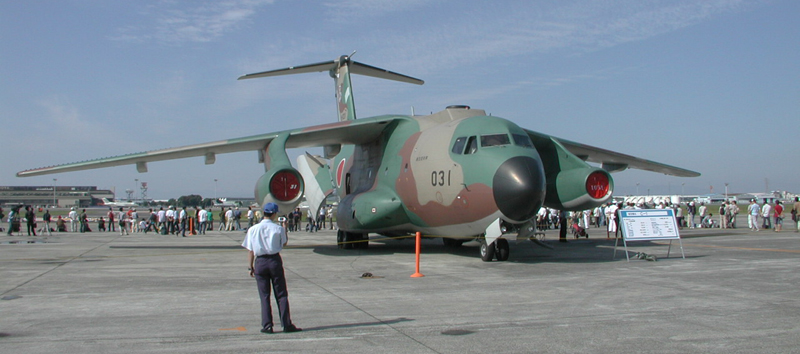- Kawasaki C-1
infobox Aircraft
name = Kawasaki C-1
type = Military Transport
manufacturer =Kawasaki Heavy Industries 
caption = JASDF C-1 displayed at Komaki AB
designer =
first flight =12 November 1970
introduced =December 1974
retired =
number built =31
status =
unit cost =$40 million / ¥4.5 billion (approx.)
variants with their own articles =
primary user =Japan (27)
more users =The Kawasaki C-1 is a twin-engined short-range
STOL military transport, used by theJapan Air Self-Defense Force . Development on it began in 1966 as theJASDF sought to replace its aging,World War II –eraC-46 Commando s, production in 1971, and it remains in use today.Development
In 1966, the
JASDF transport fleet was composed primarily ofCurtiss C-46 Commando s, a retired midwar American design built in large numbers before the end ofWorld War II . While relatively capable for its time, theC-46 did not fare well in comparison to newer aircraft such as the LockheedC-130 Hercules , and theJASDF therefore elected to replace it with a domestically-designed and -manufactured transport aircraft.For this purpose, they turned to the Nihon Aircraft Manufacturing Company, a consortium of several major corporations, which had begun to produce commercially its
YS-11 airliner four years earlier.NAMC decided thatKawasaki Heavy Industries was to be the prime contractor, and the airplane thus bears that company's name. Fully developed byKawasaki Heavy Industries and Japanese design, this aircraft has been used as military transport for theJapan Self Defense Forces since its maiden flight in November 1970.Japanese policies at the time on military equipment were strict in that they were not to have offensive capabilities, and so the maximum range was cut in order to keep the aircraft's operational range inside Japan. This proved to be a problem after
Okinawa was returned to Japan from the US, and the aircraft had trouble reaching the island from distant areas. Thus production was terminated and theC-130 was introduced.Operational history
The Kawasaki C-1 has been in use since 1974. An aircraft yet to be presented is to replace the service of the C-1 by 2010 to provide a new range of military transport services for the
Japan Self Defense Forces .Variants
*XC-1: Prototypes.
*C-1/C-1A: Medium-range military transport version.:The last five C-1s ordered were fitted with an additional 1,250 gallon (4,730 liter) fuel tank.
*EC-1: EW training aircraft.
*C-1FTB: Flight test bed used for testing various equipment.
*Asuka: Experimental STOL transport aircraft, powered by four turbofan engines and making use of theCoandă effect .:The only example built is currently on display inKakamigahara Museum inGifu ,Japan .Specifications (Kawasaki C-1)
Aircraft specifications
plane or copter?=plane
jet or prop?=jet
crew=Five (pilot, copilot, navigator,flight engineer ,loadmaster )
capacity=60 soldiers, 45 paratroopers, 36 patients with medics, or cargo
length main= 95 ft 2 in
length alt= 29 m
span main= 100 ft 4 in
span alt= 30.58
height main= 32 ft 9 in
height alt= 9.99 m
area main= 1,297 ft²
area alt= 120.5 m²
airfoil=
empty weight main= 53,450 lb
empty weight alt= 23,320 kg
loaded weight main= 85,320 lb
loaded weight alt= 38,700 kg
useful load main=17,420 lb
useful load alt=7,900 kg)
* Maximum load: 26,240 lb (11,900 kg
max takeoff weight main=99,200 lb
max takeoff weight alt=45,000 kg
more general=
engine (jet)=Mitsubishi -builtPratt & Whitney
type of jet=JT8D -M-9
number of jets=2
thrust main= 14500 lbf
thrust alt= 64.5 kN
thrust original=
thrust more=
engine (prop)=SNECMA -manufactured
type of prop=Bristol Hercules 738/739
number of props=2
power main= 2040 hp
power alt= 1520 kW
power original=
power more=
max speed main=501 mph
max speed alt=806 km/h
max speed more=at 25,000 feet at 35,450 kg AUW
cruise speed main=408 mph
cruise speed alt=657 km/h
cruise speed more=at 35,000 feet at 35,450 kg AUW
range main=806 mi
range alt=1,300 km
ceiling main=38,000 ft
ceiling alt=11,600 m
climb rate main=3,500 ft/min
climb rate alt=17.8 m/s
loading main=76.48 lb/ft²
loading alt=373.8 kg/m²) (max
thrust/weight=
power/mass main= hp/lb
power/mass alt= kW/kg
more performance=
armament=ee also
aircontent
related=
similar aircraft=
*Kawasaki C-X
sequence=
* C-1
lists=
*List of military aircraft of Japan
see also=
Wikimedia Foundation. 2010.
